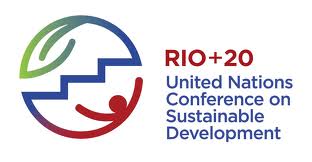Earth Summit Rio+20: Driving the agenda forward
Four Maryknollers attended the United Nations Earth Summit Rio + 20 which took place in Rio de Janeiro, Brazil in June 2012. Sr. Ann Braudis, one of the participants, wrote the following reflection for the July-August 2012 NewsNotes.
One of the achievements of the first Rio Conference in 1992 was the creation of a system for including civil society in the United Nations work for sustainable development through the formation of nine major groups. One of the established groups is labeled non-governmental organizations (NGOs) which is the category that encompasses Maryknoll for purposes of UN work. Maryknoll brings to the international table voices of marginalized people, particularly women and children, from many forgotten corners of the globe. It brings anthropological and theological perspectives rooted in hope and the promise of fullness of life. It brings as well the work of the Maryknoll Office for Global Concerns regarding moving beyond the current economic model rooted in unsustainable growth; and the critique of gross domestic product (GDP) as a development measure.
A significant major group category is science and technology. Throughout the past decades, the scientific organizations that belong to this UN major group have engaged in sustainable development research rooted in the nature of the planet and its boundaries and have worked relentlessly to establish consensus within the scientific community concerning their findings. Within the UN arena, respect for the scientific community is more and more in evidence.
The Rio Conference opened with a brief and stunning animated film produced by the Planet under Pressure conference, held in London in March, just prior to the Rio Summit. The title of the film is Welcome to the Anthropocene (www.anthropocene.info) and it demonstrates the scientific community’s capacity for translating its findings into compelling language and visuals. Anthropocene is a fairly new word; it refers to humanity as a global force on the scale of the major geological processes experienced by the planet in its formation through the millennia. The film acts as educator regarding the unsustainable influence of modern humanity on the planet and as source of inspiration toward shaping the future we want. It provided a dramatic opening to the conference, which was the United Nations’ largest ever.
In this age of the Anthropocene it is difficult for state leaders to provide the vision and leadership needed to guarantee a sustainable future because they are constrained by the current urgent needs of their states, as they understand them. Thinking and acting in planetary terms are skills that have yet to be developed. However, thanks to the tireless work of the scientific community, negotiators have been nudged to a new border from where it can be seen that a sustainable future will require the best knowledge available regarding the planet and its boundaries. It is significant that the outcome document, The Future We Want, adopted by all the nations present at the Summit, states repeatedly the necessity to base decisions for the future in science based fact. In itself this is a large achievement. Awareness or consciousness must precede action.
Speaking to the representatives of the major groups at the Summit, UN Secretary General Ban Ki-moon noted that the present time is very rich because of all that is known and can be done but also very complex with immense challenges for multilateral processes and negotiations. He noted that the Summit outcome document is weaker than we would have wanted and that the negotiations were slow and painful. However, he pointed out, to have been able to reach agreement after such prolonged and difficult dealings beginning last December in New York, is nothing less than extraordinary. At the very least humanity has decided to go forward together to build a sustainable future.
Hopefully, implementation will match this aspiration. He thanked each of the major groups for providing essential information and depth of vision and values and asked that we continue to raise the voices of the world, particularly in the work ahead in delineating the Sustainable Development Goals (SDGs) which are mandated by the outcome document. This work will begin in the fall under the auspices of the UN General Assembly. It will be important to ensure that these goals are informed by scientific findings.
While it is expected that the SDGs may become the most important practical outcome of the Summit, another significant achievement is the call to replace GDP with a new metric that will include emerging ideas concerning environmental, social and economic progress.
The Rio+20 outcome document is 53 pages long. It reaffirms and builds on the amazing documents that were produced in the first Rio Summit in 1992. As Ban Ki-moon said in his address to the major groups, Rio 1992 made the sustainable development map; now we must use the map and drive the agenda forward.

